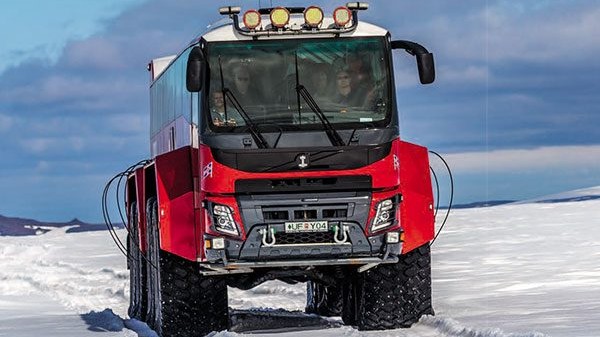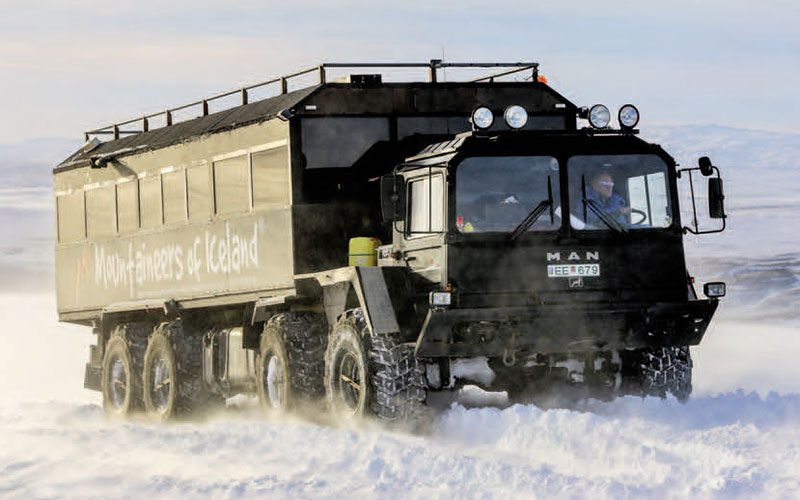
Tourists visiting Iceland will be thankful for the comfort and safety of its fleet of specialist off-road buses.
Iceland lies way out west at the edge of the Atlantic and Arctic Oceans. The least populated country in Europe, its climate is unpredictable, with moderate summers and extreme winters. Yet the barren wilderness with volcanoes and hot-water geysers in the interior each year attracts tens of thousands of tourists from around the world.
However, the 103,000m2 island has only good roads along the coast where most inhabitants live. Special off-road vehicles are needed to reach the lakes, glaciers, waterfalls, hot springs and volcanoes – very special on/ off-road vehicles. Initially, old 4×4 drive vans and trucks were converted by local entrepreneurs to carry tourists to the inland attractions. These makeshift ‘buses’ performed reasonably well on the unsurfaced tracks in summertime. But under severe winter conditions, with lots of snow and ice, much stronger and more reliable people carriers were needed. Hence, Jeeps, SUVs and 4×4 vans were partly replaced by large truck-based off-road buses.
A few local tourism operators decided to design and build these all-wheel- drive vehicles themselves. Their inspiration came from Canada, where Foremost had custom-built the Terra Bus for more than 20 years. This high- wheeled behemoth provided all-terrain mobility to transport 50 or 60 passengers to the famous Columbia Icefield in the Rocky Mountains. Equipped with large, low- pressure tyres, the 6×6 drive Terra Bus could tackle almost any winter situation. The Foremost differs from the early Icelandic people-moving bus trucks in that the latter were not completely purpose- built but based on existing heavy-duty off-road chassis.
About 20 years ago, Mountaineers of Iceland engineer Haukur Herbertsson came up with the idea to build the first off-road mega bus. Having participated in the famous Dakar Rally himself, Haukur had witnessed the military-style MAN 6×6 conquering with ease the soft sand of the Sahara Desert. He concluded that this type of heavy off-road vehicle could perfectly overcome the Icelandic snow conditions. Mountaineers of Iceland decided to build up a heavy-duty truck chassis as a bus and opted to do the conversion rather than go to a costly European specialist. In the capital of Reykjavik, in a rented workshop, the passenger body was welded, painted and mounted on the second-hand MAN 6×6 chassis. The 44-seat passenger body came from an old bus. Big Michelin R20.5 XSTL off-road tyres were fitted.
This setup worked well, but it was found that a heavier four-axle chassis with a more powerful engine could do the job even better. So, an ex-army MAN KAT 1 chassis was imported from Europe. The 8×8 was powered by a 320kW (430hp), 14-litre Deutz BF8L diesel engine. The 3m-wide and 10.27m-long chassis received a locally built 58-seat bus body.
Unfortunately, the new vehicle turned out to be impossible to register with the Icelandic road authorities. The truck bus was too wide and could, for example, not reach the capital of Reykjavik, where the bulk of tourists arrive. It was only possible to operate the KAT 1 far away from public roads. Mountaineers of Iceland then decided to acquire a new on/off-road bus with an all-wheel-drive with a width of 2.5m. Special vehicle company Vélrás EHF of Reykjavik was asked to build it. The new off-roader was based on a similar MAN KAT 1 8×8 chassis with a 290kW (390hp) D20 diesel engine, but then fitted with a narrower MAN TGA cab. The 16 R20 off-road tyres came again from Michelin. A sturdy Dutch Bova bus body was mounted on the chassis that could accommodate 49 passengers. The finished vehicle was registered as a BovMAN I.
Vélrás was also responsible for the construction of the BovMAN II, based on a new MAN TGS 8×8 heavy-duty truck chassis. This unit featured a full Arctic package for operating in extreme polar conditions. Power came from a 12.4-litre MAN diesel of 358kW (480hp), hooked to a 16-speed ZF transmission. Contrary to the first KAT 1 based buses, the BovMAN’s had no partition between the driver’s cabin and the passenger ‘salon’. The single body improved safety because it had a greater strength and enabled the driver and guide to communicate directly with the passengers. Mountaineers of Iceland also imported a Dutch-built Ginaf X5450S 10×10 drive chassis with a 345kW (462hp) PACCAR MX13 engine and a 12-speed ZF AS-Tronic transmission. The 60-seat Bova body also came from the Netherlands.
Tour operator Sleipnir is another user of purpose- built off-highway bus trucks. Its first 4-axle AWD bus was based on a used E-One Titan crash-tender from the United States. The impressive machine is powered by a 633kW (850hp) Caterpillar C18 diesel engine and an Allison automatic transmission. This tour operator designed and built its own 48-seat passenger body. The mastodont runs on huge low-pressure tyres of 90cm width that are normally fitted to construction equipment. An automatic tyre pressure system is also part of the package. The 15m-long 8×8 can overcome crevices up to 3m wide, and its maximum speed on a glacier is 60kph.

The bus interior is surprisingly comfortable with leather passenger seats and individual heating. A toilet and kitchen are fitted in the back. Designing and constructing the Sleipnir bus took nearly three years and cost more than UD$500,000. From the front, the off-road giant looks like it is based on a recent Volvo chassis. But that is not the case. Only the front panel comes from a Volvo FMX truck. The bus body is 3m wide but 3.5m over the wheels.
The latest acquisition of Sleipnir, however, is an off- road bus that uses a Tatra Phoenix 8×8 chassis of 2021. One of the reasons to construct it was that the vehicle is equipped with a PACCAR MX13 diesel that complies with Euro-6 emission standards. The 395kW (530hp) engine is coupled to an Allison 4700 automatic transmission. As with the other vehicles, the body was designed by Sleipnir engineer Astvaldur Oskarsson. The interior has 36 comfortable leather seats and includes a toilet. The DAF CF-cabbed 8×8 bus has the unique Tatra chassis concept and driveline with a central backbone tube and independent half-axle suspension. This setup offers excellent off-road capabilities and driver/passenger comfort on the challenging tracks to the breathtaking wonders of Iceland.
Read more
Visiting the vikings
0 Comments1 Minute
Is California dreaming?
0 Comments17 Minutes
The Foden way
0 Comments7 Minutes
Red-tape resilience
0 Comments12 Minutes












